Table of contents
- Buying advice: big bikes The big bike generation from 1984
- Yamaha FJ 1100 (1984-1985)
- Suzuki GSX 1100 EF (1984-1987)
- Kawasaki GPZ 900 R (1984-1993)
- Honda VF 1000 F (1984-1987)
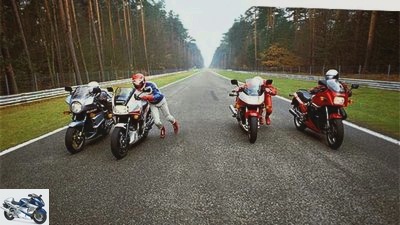
archive
counselor
Used purchase
Big bikes from Honda, Suzuki, Kawasaki and Yamaha
Buying advice: big bikes
The big bike generation from 1984
Content of
For the 1984 season, the four Japanese manufacturers are presenting a new generation of big bikes whose engine performance and technical level overshadow everything that has come before.
Uli Holzwarth
04/13/2012
Autumn 1983. The signs point to a storm, everything is being upgraded. In Washington and Moscow, but also in Akashi, Hamamatsu, Iwata and Tokyo. While the world is looking at the muscle games of the Cold War between the two superpowers with increasing unease, the motorcyclists are enjoying the technical overkill of the Japanese displacement bolides with unbroken enthusiasm. PS instead of Pershing – with the sports cannons of the 1984 season, the big four hit the bull’s eye with big bike fans.
That is also urgently needed. Because the reputation of the Japanese two-wheeler manufacturers has suffered a lot. Although the Japanese had the German motorcycle market firmly under control at that time with a sales share of 87 percent, not all that glitters is gold. The overproduction of previous years is flat in the warehouses. The bikes are pushed into the market at junk prices. That scratches the image and puts a lot of pressure on the margins. Honda, Kawasaki, Suzuki and Yamaha respond to model year 1984 with drastically reduced model programs. And an unprecedented technology offensive for the prestigious and profitable luxury class cars. Every Japanese manufacturer sends a new development into the race for the best big bike.
Fashion trend 16-inch wheels
A 16-inch wheel rotates between the fork legs on all of them. They are very popular in 1983, as they promise more agile handling thanks to reduced gyroscopic forces and, at the same time, better deceleration due to the wider contact area of the 120 tires. There is also agreement on the rear suspension, here and there a central spring strut should improve comfort and road holding. Otherwise, however, the sporty quartet differs considerably: With the VF 1000 F, world market leader Honda is also relying on the V-four-cylinder in the one-liter class, which caused a sensation in the 750 series the year before. With water cooling, hydraulically operated anti-hopping clutch and the independent, sonorous sound, which at least acoustically clearly sets it apart from the in-line four-cylinders of the competitors.
Evolution instead of revolution, on the other hand, is what Suzuki says. The air-cooled inline four-cylinder, which celebrated its premiere in 1980, continues to work in the new chassis of the GSX 1100 EF. With more displacement and extensive detail changes, the robust four-cylinder, still with roller bearings, is almost like a new design. The 1135 now pushes even more brawny, which is especially useful for lazy touring riders who also appreciate the effective wind protection of the voluminous full fairing. Compared to the Suzuki, the other 1100, Yamaha’s completely new FJ, looks almost petite. In the case of the FJ 1100, which has been praised by the manufacturer as the new benchmark for super sports cars, the 16-inch rear wheel is also responsible for the short wheelbase, the low seat height and the compact, air-cooled four-cylinder with its piggy-back alternator.
The most uncompromising concept of the 1984 vintage, however, is Kawasaki with the GPZ 900 R on the wheels. Here the engineers were allowed to start on a blank sheet of paper. The result: a thoroughbred athlete whose explosive performance is just as impressive as the new frame concept, which integrates the astonishingly narrow, water-cooled four-cylinder as a load-bearing part. The striking design of the slim 900 series is also very independent, which is why not only Kawasaki, but also many scene connoisseurs celebrate the GPZ as a milestone in motorcycle history when it is presented. Which doesn’t change the fact that the super sporty Kawasaki has to admit defeat in the first big bike comparison of the Yamaha with its better all-round properties. Behind: Suzuki and Honda, who missed a better position due to chassis weaknesses.
GPZ with classic potential
Today, however, youngtimer fans no longer count the points of yore, but rather character, reliability or originality. In other words, these are characteristics that make up the classic potential of an 80s bike. Seen in this way, even the once a little baroque looking Suzuki GSX 1100 EF has its charms with its enormously powerful engine and sovereign charisma. It’s not that easy with the Honda, which has a dubious reputation to this day due to initial engine problems. Exactly the opposite is true for the Yamaha. However, so far price-conscious big bike pilots have primarily benefited from the resilience of the FJ models, but less so from the status of the classic. That is most likely to be seen in the Kawasaki. Well-maintained and untampered GPZ 900 Rs in their original condition are becoming rarer, the prices have already bottomed out here.
Yamaha FJ 1100 (1984-1985)
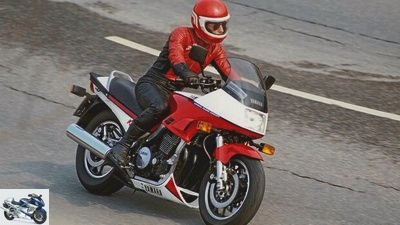
Holzwarth
Yamaha FJ 1100 (1984-1985).
Price 1984: 12,748 marks
Ride
Sit up and feel good, the FJ still conveys this feeling today. Drivers up to around 1.85 meters are perfectly integrated, while the smaller ones enjoy the seat height of just 78 centimeters. A heavy chunk when pushing it, the 1100 just seems to shed several pounds as soon as it rolls. She willingly reacts to every move on the handlebars in brisk alternating curves, but needs a determined hand in slow turns. Like so many bikes with 16-inch front wheels, the FJ also shows a self-steering behavior and wants to make the radii tighter than desired – a matter of habit. This also applies to the engine, but only in a positive sense. Anyone who has found pleasure in the emphatic, easily controllable thrust of the 1100, perhaps even in the unthrottled version, will no longer want to do without it. Nowadays, however, you want a little more lean angle, more snappy brakes and fuller damping spring elements from the accessory shelf for fast curve swing.
technology
The history of the FJ engine is somehow reminiscent of a valuable family jewel that was passed on from one generation of developers to the next for care. Almost three decades have passed since the FJ 1100 debuted. And Yamaha’s four-cylinder icon still defiantly puts its cooling fins in the wind. It is mainly thanks to this engine Methuselah that the XJR 1300 stands out so nicely from its sleek, well-known naked bike competitors. Back then, at the end of 1983, the newly developed four-valve engine still had to prove itself as a super sports car. Which he did remarkably well even against the liquid-cooled rookies from Honda and Kawasaki. Yamaha’s first big bike four-valve engine had a conventional design: crankshaft with plain bearings, two overhead camshafts with central chain drive that operate the 16 valves via bucket tappets, an alternator piggybacked behind the cylinders, and hydraulically operated clutch – the usual Japanese standard of those days. Constructively, Kawasaki and Honda had digged much deeper into their bag of tricks. But also no more pressure to offer. Especially in the unthrottled, 125 hp foreign variant, the FJ 1100 confidently parried the attacks of the competition. The unusual frame layout, dubbed “Lateral Frame” by Yamaha, attracted more attention. It spans the side of the engine with a direct connection between the steering head and swing arm bearings and supports the steering head in a complex manner. Advantages: Better torsional stiffness and easily accessible engine. The basic requirement for a compact big bike, which the 16-inch wheels underline.
Checkpoints
The FJ models – including the 1200s – are among the most reliable big bikes. If more serious damage does occur, it is mostly due to high mileage and the associated wear, but rarely to structural weaknesses. The few that plague the FJ are rather harmless. But still annoying. For example, vibration damage to the fairing (cracks) and exhaust (rattling baffles, on the 1100 also manifold) or the not particularly stable clutch, which often slips. In addition, a tightly driven FJ likes to take an extra sip of oil when doing higher mileage. In terms of the problems faced by many competitors, however, these are peanuts. When visiting an FJ, prospective buyers can therefore concentrate primarily on checking worn parts.
market
An FJ is a safe bet. Not just for the buyer, but also for the seller. Because well-kept specimens always find a new owner if the price is within the usual range. It starts at around 1000 euros for long-distance machines in good condition with a mileage of around 80,000 kilometers and goes up to 3000 euros for the most popular 1200 model 3CW with less than 30,000 kilometers on the clock. FJ fans with a vision also have the 1100s in focus. The original model, only sold 3276 times, has all the systems for the future classic.
Specialists
Since the air-cooled four-cylinder of the FJ 1100 has survived to this day as the drive of the XJR 1300, every Yamaha dealer knows it inside out.
Clubs and forums
The FJ has a large fan base who exchange information in numerous Internet forums and IGs. Here is just a small selection: www.carookee.de, www.das-fj-forum.de, www.effjott-ig.de, www.fj1100.com, www.fjowners.com
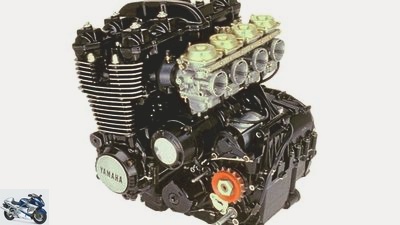
Holzwarth
Conventional but powerful: the air-cooled four-cylinder of the FJ has survived to this day in the XJR.
character
It should be a super sports car, the FJ 1100. At least that’s how Yamaha wanted to understand the comparatively compact displacement car, which rolled on 16-inchers both front and rear. The manufacturer was particularly proud of the “Lateral Frame”, a frame construction familiar from racing and the early Bimota models. But the customers weren’t fooled. And preferred to travel with the FJ instead of going to the racetrack. That’s what happens when you build a powerful motorcycle with a comfortable seating position, pleasant suspension and a 24-liter fuel drum that is also very reliable
Data (type 47E)
engine:
Air-cooled four-cylinder four-stroke in-line engine, two overhead camshafts, four valves per cylinder, actuated via bucket tappets, displacement 1097 cm³, output 74 kW (100 PS) at 9000 / min, max. Torque 87 Nm (8.9 mkp) at 7500 / min
Power transmission:
Multi-disc oil bath clutch, five-speed gearbox, chain drive
landing gear:
Double-loop square tube frame made of steel, telescopic fork, Ø 41 mm, two-arm swing arm made of aluminum profiles, central spring strut, cast aluminum wheels, tires 120/80 V 16 at the front, 150/80 V 16 at the rear, double disc brake at the front, Ø 282 mm, two-piston fixed calipers, disc brake at the rear
measurements and weight:
Wheelbase 1490 mm, weight with a full tank of 261 kg
Performance:
0-100 km / h 3.6 sec, top speed 220 km / h
history
- 1986: Four millimeters more bore turn the 1100 into the FJ 1200 (type 1XJ). Abroad, 130 HP are available, in Germany it remains at 100 HP. New: the slightly grown fairing with integrated indicators and a digital clock in the cockpit. Price: 13,888 marks.
- 1988: Second evolutionary stage. The FJ 1200 (type 3CW) now without anti-dive, but with more wind protection, 17-inch front wheel, floating brake discs, four-piston brake calipers, new seat, digital ignition and electric fuel pump (14,710 marks).
- 1991: Last update of the FJ 1200 (type 3YA), recognizable by the newly styled fairing. Also available with ABS. Motor is no longer supported in silent blocks, therefore larger frame cross-sections are necessary. Swing arm now made of steel instead of aluminum (from 15,950 marks).
Suzuki GSX 1100 EF (1984-1987)

Schwab
Suzuki GSX 1100 EF (1984-1987).
Price 1984: 12,899 marks
character
There is no substitute for cubic capacity – unless with even more cubic capacity. With this classic concept, Suzuki tried to stand up to the stronger and, on the drive side, much more modern competitors. What the GSX 1100 EF easily achieved with its enormously powerful four-cylinder. Although the new chassis with 16-inch front wheel and central spring strut was aimed at athletes, the big Suzi was more a case for more leisurely touring riders. This was not only due to the lush full fairing, but also to the not always stable driving behavior at high speeds.
Ride
With the GSX 1100 EF, the engine is clearly at the center of what is happening and feeling. How easily and casually this immensely beefy four-cylinder unit releases its forces is still exciting, even in comparison to current big bikes. The 1135 four-cylinder set off at full throttle from idle. At around 5000 tours, the mechanically loud and robustly vibrating rough leg then unpacks the very large torque lobe, rips the heavy load from 60 to 140 km / h in just eight seconds – in fifth gear, mind you. Oh, it could be so nice to enjoy the performance over and over again with just a little twist of the wrist. If only the chassis displayed a similar aplomb. But it doesn’t. At least at a accelerated pace. Even with new tires, the GSX 1100 EF tends to oscillate at speeds over 180 km / h and is also sensitive to longitudinal grooves. A sensitivity that increases uncomfortably when the tires are worn out. So out the gas. Winding country roads are more fun. Despite the long wheelbase, fat Suzi goes around corners very well mannered. The fluttering nature of the front 16-inch model between 50 and 90 km / h and the noticeable top-heaviness, however, take some getting used to. On mogul slopes at the latest, even leisurely bikers will find out that there is a need for action on the GSX chassis. Both the elaborate fork and the overdamped shock absorber distribute more than they take in. However, these malaises can be turned off comparatively easily with higher quality spring elements. In the hands of courageous pilots in the popular classic racing series, it proves again and again that the chassis can’t be that bad.
technology
No water cooling, no hydraulically operated clutch, no crankshaft with slide bearings – even as the 1135, the GSX four-cylinder, which has been built since 1980 and still has roller bearings, has remained true to itself. But with the increase in displacement and many detailed modifications, the four-valve engine kept up with the more modern big bike competition. Suzuki did not stop at simple drilling (74 instead of 72 millimeters bore), but enlarged the intake valves by two to 34.5 millimeters, enlarged the intake ducts (28 instead of 27 millimeters) and increased compression (from 9.5 to 9.7 ) and made it easier for the engine to breathe with a size 36 carburetor (previously a size 34) and a larger air filter. The result: 115 hp, which in Germany were throttled to the usual 100 hp via tamer control times and an adapted exhaust. For more stability, the clutch and piston pin have also been reinforced, and the oil cooler that has now been installed also increases the lubricant fill quantity by 300 cm³. Completely new: The frame with the full floater central spring strut, consisting of round tubes with rectangular beams. Compared to the predecessor, the wheelbase and steering head angle have been increased to match the 16-inch front wheel. The developers were also proud of the new fork, which instead of the brake-operated anti-dive feature a four-way adjustable compression damping to prevent excessive immersion.
Checkpoints
Suzuki’s roller-bearing power pack had matured into a stable endurance runner in its final expansion stage. The clutch problems or hairline cracks in the cylinder head between the exhaust valves and the spark plug hole, which occurred more frequently with the predecessors, are no longer an issue with the 1135 engine thanks to the oil cooler. Nevertheless, a high consumption of lubricants is one of the problematic signs of aging of this type. The cause is the (too) thin oil control rings on the pistons, which wear out quickly. Incorrect oil or a valve clearance setting that is not 100% adversely affected the hard chrome layer of the fork finger followers. If this flakes off, the camshafts will be damaged. Furthermore, problems with the starter freewheel are not uncommon. Otherwise, however, the durability and supply of parts for the drive are good. What is no longer available from Suzuki can often be found as a spare or tuning part in the accessories. Speaking of tuning: For classic racers, the robust 1135 is the best basis for increasing performance, with up to 180 hp.
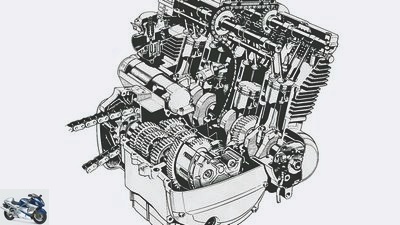
archive
Kraft-Werk: At 1135 cm3, the GSX was the most powerful bike.
market
The GSX 1100 EF and its two sister models are rarities in Germany, only around 200 are allowed. The low demand ensures a moderate price level. Real fans of this GSX are apparently more likely to be found in classic races than on tour.
Specialists
Old school superbikes
Ingo Wrubel has been working with the GSX models for a long time, repairing and tuning them. Telephone 045 41/85 79 99
www.old-school-superbikes.de
Internet
www.suzuki-classic.de, www.suzukicycles.org
Data (type GV71C)
engine:
Air-cooled four-cylinder four-stroke in-line engine, two overhead camshafts, four valves per cylinder, operated via fork rocker arms, displacement 1135 cm³, output 74 kW (100 PS) at 8100 rpm, max. Torque 96 Nm (9.8 mkp) at 6500 / min
Power transmission:
Multi-disc oil bath clutch, five-speed gearbox, chain drive
Chassis: Double loop frame made of tubular steel with square beams, telescopic fork, Ø 37 mm, two-arm swing arm made of aluminum box profiles, central spring strut, cast aluminum wheels, tires 110/90 V 16 at the front, 130/90 V 17 at the rear, double disc brake at the front, Ø 280 mm, two-piston -Fixed caliper, rear disc brake
measurements and weight:
Wheelbase 1540 mm, weight with a full tank of 256 kg
Performance:
0-100 km / h 3.7 sec, top speed 218 km / h
history
- 1985: The undisguised GSX 1100 E weighs 13 kilograms less, drives noticeably more manageable and more harmonious than the EF. The price for the bare E: 10,990 marks
- 1986: Interim solution: The GSX 1100 receives a half-shell and is now called ES. Less disguise is also noticeable in the price, the ES costs 11,699 marks
Kawasaki GPZ 900 R (1984-1993)
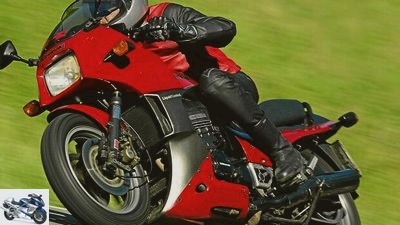
archive
Kawasaki GPZ 900 R (1984-1993).
Price 1984: 11690 marks
character
Completely redesigned, the GPZ 900 R set standards when it was presented at the end of 1983, similar to the Z1 with the same displacement a decade earlier. Back then, no other big bike offered comparable driving dynamics as the consistently sporty GPZ. Outstanding in the coherent overall package was Kawasaki’s first four-valve engine. A real hit that impressed with its explosive power delivery, excellent driving performance and a remarkable level of fitness. The 900s also confirmed this in the MOTORRAD endurance test over 100,000 kilometers: boring out the cylinders and a set of oversized pistons were enough to get the Kawasaki back into shape.
Ride
How well Kawasaki managed the GPZ 900 R can still be seen even after almost 30 years. For such a heavy chunk, it steers surprisingly easily and precisely through curves, even the 16-inch front wheel and the brakes are not a spoilsport. The driving stability is also okay, although the very tight spring elements require a certain ability to suffer. Current accessories spring elements provide a remedy. Add a pair of contemporary tires and you can safely savor the still impressive vitality. It’s great how the cultivated four-cylinder depends on the gas, especially on higher tours. The bang from below is really only missed by those who cannot gain anything from the afterburner effect from 7500 rpm – or who think of eating rather than switching with six courses.
technology
With the first four-valve engine from Kawasaki, the developers placed the main focus on high peak performance, which was stated abroad with 115 hp (throttling to 100 hp via modified carburetor cover). Characteristic features of the GPZ engine were the elaborate liquid cooling with three temperature sensors, the valve control via fork rocker arms and the timing chain that ran sideways for the first time, which is now part of the standard repertoire of all power bikes. The latter not only saved a crankshaft bearing, but also made the plain-bearing shaft shorter and stiffer. To further reduce the overall width, the chain-driven alternator was moved piggyback behind the cylinders. The water and oil pumps were on their own shaft, driven by the transmission input shaft. The motor, which was bolted directly to the backbone frame as a load-bearing part, was given a gear-driven balancer shaft that rotated below the crankshaft at twice the speed. The three-part chassis, consisting of tubular steel backbone, aluminum stern and the side aluminum plates with the footrests, which also served as the swing base, was also cleverly made.
Checkpoints
The condition of the GPZ engine is at least as impressive as the high output. The four-valve engine, with a mileage of over 100,000 kilometers, thanks regular care and careful warm-up. Which is why we generally recommend a copy with a comprehensible history. Best from 1987 onwards. Before that there were problems with timing chain tensioners and guides, valves that were too soft, including seats and twisted carburetor diaphragms. There were also material eruptions on the camshafts (pitting) as a result of high engine speeds when the engine was cold. Unfortunately, the oil supply lines to the camshafts, which were enlarged from 1986 onwards, are not an effective measure against such abuse. In case of doubt: hands off. Or at least take a look under the valve cover. Overflowing carburettors are still not unknown. Cause: worn float needle valves. As a result, the oil can be diluted by gasoline, which is not exactly beneficial for the service life of the engine. The chassis causes few problems. You can see rubbing brake discs during a test drive, and torn off engine retaining bolts after removing the side aluminum plates. It is also mandatory to check the bearings and reversing levers of the central spring strut.
market
Despite the large inventory – Kawasaki sold just under 12,000 of the GPZ 900 Rs – it is now no longer so easy to get hold of a top specimen free from falls and with traceable mileage of up to 30,000 kilometers. However, anyone who wants to put a 900 in the garage today should concentrate on such pearls, even if the price demands for them start at around 2500 euros. With offers over 3500 euros, the air for GPZ providers is thin.
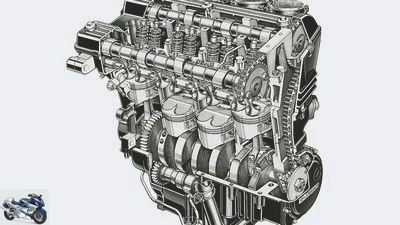
archive
Pioneer: The left-hand timing chain of the GPZ enables a narrow design.
Specialists
Hansle Motorradsport phone 078 22/4 45 80, www.haensle.de
Internet
www.r900.de – THE German site for the GPZ, professionally designed and very informative, plus many links. www.luehdorf.de – Frank Luhdorf offers a lot of interesting information about technology.
Data (type ZX900A1)
engine:
Water-cooled four-cylinder four-stroke in-line engine, two overhead camshafts, four valves per cylinder, operated via fork rocker arms, displacement 901 cm³, output 74 kW (100 PS) at 9500 / min, max. Torque 85 Nm (8.7 kpm) at 8500 / min
Power transmission:
Multi-disc oil bath clutch, six-speed gearbox, chain drive
Chassis: backbone frame made of tubular steel with screwed aluminum rear, telescopic fork, Ø 38 mm, two-arm swing arm made of aluminum profiles, central spring strut, cast aluminum wheels, tires 120/80 V 16 at the front, 130/80 V 18 at the rear, double disc brake at the front, Ø 280 mm, single-piston floating calipers , Rear disc brake
measurements and weight:
Wheelbase 1495 mm, weight with a full tank 257 kg
Performance:
0-100 km / h 3.6 sec, top speed 241 km / h
history
- 1984: First model year of the GPZ 900 R. Air-assisted fork with anti-dive system, plus 16-inch front wheel and single-piston floating caliper brakes
- 1986: As the new sporty top model, the GPZ 1000 RX with 125 hp abroad is to inherit the 900 series. But it doesn’t work: too heavy, plus chassis weaknesses (15 160 marks)
- 1990: More in-depth revision. New: fork (Ø 41 mm), 17-inch wheel at the front, wider rim at the rear, four-piston brake calipers at the front (14 140 marks)
Honda VF 1000 F (1984-1987)
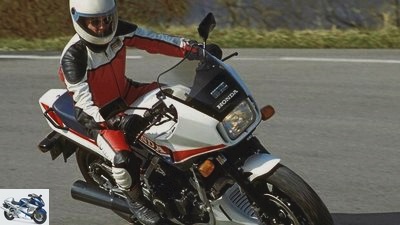
archive
Honda VF 1000 F (1984-1987).
Price 1984: 12,918 marks
character
Honda praised the VF 1000 F in its debut year as the new benchmark for technology. Accordingly, the world market leader spared no effort to get bikers to switch from the inline four-cylinder to the V4. The advantages of the new technology were highlighted in multi-page advertising campaigns. In fact, the sonorous and completely independent sounding V-four-cylinder impressed with a homogeneous, extremely powerful power output, which fit perfectly with the concept of the VF 1000 F. As a sporty all-rounder, it was supposed to bring travel and lawn under one roof, but it did not meet this requirement due to the initial weaknesses in the chassis.
Ride
Such a V4 has something. In any case, with the VF 1000 F it is the engine that has a decisive influence on the driving experience. A bull of strong character with polished manners, who masters all types of an inspiring engine from the powerful thrust in the lower rev range to the distinctive sound to the enormous temperament on high tours. With its even power development and the wide usable speed range, it can be lazy to change gear as well as gazing heartily. However, the unstable chassis of the 1984 model quickly reached its limits. The Honda commutes in fast corners, at a moderate pace it looks nervous and wobbly. Which is mainly due to the small 16-inch front wheel, which also has a tendency to flutter the handlebars and the uncomfortable positioning when braking in an inclined position. The spring elements also urge moderation, due to a lack of sufficient damping, the rear in particular rocks. Fortunately, the accessories industry has proven tranquilizers for the Honda VF 1000 F.
technology
Clutter, not mess was the motto with which Honda wanted to convince the customers who had previously been sworn to the inline four-cylinder of the V-engine principle. As advantages of the significantly more complex design, Honda cited the more compact dimensions, the optimal mass balance, a more favorable center of gravity and the short, stiff crankshaft, which, in combination with the short stroke, should be able to cope better with high speeds. Although the one-liter engine was very similar to that of the VF 750 F, the VF 1000 F, which had 116 hp abroad, had a new V4 that was more generously dimensioned in almost all components (throttling to 100 hp via longer throttle slides). Instead of gear cascades as in the VF 1000 R, the limited racing replica with 130 hp that was offered at the same time, the civilian F had to be content with two tooth chains to drive the camshafts. The wet cylinder liners screwed to the housing – they were washed directly by the cooling water – were also owned by the F. In it, the 77 millimeter pistons of the extreme short-stroke engine covered a distance of 53.6 millimeters, the displacement was 998 cm³. Fork rocker arms with adjusting screws made it easier to adjust the valve clearance, and as on the 750, an anti-hopping clutch was used on the 1000. For the chassis, the technicians trusted a square tubular steel frame that encompassed the engine on the sides. The wheel guides were taken over by an air-assisted 41 fork with Antidive at the front and an aluminum swing arm at the rear, which was connected to the central spring strut via a lever. And of course the VF 1000 F had to follow the fashion trend towards the 16-inch front wheel initiated by Honda.
Checkpoints
Numerous camshaft damage, overheating problems, carburetor hiccups and a wobbly, nervous chassis plagued the VF 1000 F of the first model year. Prospective buyers should therefore limit the selection to specimens that can be shown to have benefited from the modifications made at the time. So Honda exchanged the camshafts for more stable specimens, replaced water pumps and offered conversion kits for the carburettors when there were visible material breakouts. Such revised engines can achieve six-figure mileage with good care, because apart from the mentioned malaises, the V4 proved to be quite robust. If you want to be on the safe side, you can still choose one of the extensively revised, stable VF models from 1985.
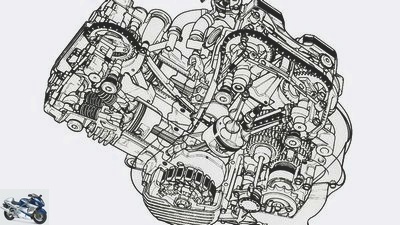
archive
V for Victory: The 90-degree V four-cylinder should be Honda’s new flagship. Many teething troubles thwarted this.
market
The bad reputation sticks to the VF 1000 F like chewing gum to the soles of a shoe. Consequence: prices at an absolute dumping level. Even the thoroughly improved types from 1985 onwards are only in top condition if the 2000 euro barrier is undercut. On the other hand, the offer is rather sparse, the restrained interest in the past probably caused many VF 1000 F to end as part carriers.
Specialists
Maniac Motors – Alex Nolte offers many tips, parts and modifications for the SC15 at www.maniacmotors.de.
Clubs and forums
While there is also a German website for the R models (www.vf1000r.de), good F information is only available in English at www.vf1000.com.
Data (type SC 15)
engine:
Water-cooled four-cylinder, four-stroke V-engine, mounted transversely, two overhead camshafts, four valves per cylinder, actuated via fork rocker arms, displacement 998 cm³, output 74 kW (100 PS) at 9500 rpm, max. Torque 83 Nm (8, 4 mkp) at 7500 rpm
Power transmission:
Multi-disc oil bath clutch, five-speed gearbox, chain drive
landing gear:
Double loop frame made of square profiles, telescopic fork, Ø 41 mm, two-arm swing arm made of box profiles, central spring strut, Comstar composite wheels, tires 120/80 V 16 at the front, 140/80 V 17 at the rear, double disc brake at the front, Ø 276 mm, double-piston floating calipers, disc brake at the rear
measurements and weight:
Wheelbase 1505 mm, weight with a full tank of 261 kg
Performance:
0-100 km / h 3.6 sec, top speed 239 km / h
history
- 1985: After criticism of the driving behavior and engine problems, the VF 1000 F received an 18-inch front wheel and numerous modifications to the engine and peripherals in its second model year. Also new: longer swing arm, reinforced frame with modified geometry (13,242 marks)
- 1985: Honda provided the fully encased VF 1000 F II with the revised F model. The 277 kilogram travel steamer received all the model maintenance measures for the half-shell model, as well as newly designed instruments. Both models benefited noticeably from the improvements in detail (13,998 marks)
Related articles
-
Comparison test: Honda Hornet, Kawasaki Z 750, Suzuki GSR 600
Jahn motorcycles Comparison test: Honda Hornet, Kawasaki Z 750, Suzuki GSR 600 Comparison test: Honda Hornet, Kawasaki Z 750, Suzuki GSR 600 ABS shooters…
-
Middle class bikes from Yamaha, Kawasaki, Suzuki and Honda
fact 27 pictures fact 1/27 Comparison of mid-range motorcycles from Yamaha XJ6 Diversion F, Kawasaki ER-6f, Suzuki GSX 650 F and Honda CBF 600 S. fact…
-
Comparison test: Honda CBF 1000 Silverline, Suzuki Bandit 1250 S, Yamaha FZ1 Fazer
Jahn 22nd pictures Honda 1/22 Honda CBF 1000 Honda 2/22 Honda CBF 1000 Zdrahal 3/22 Presentation at the fair in Paris. Honda 4/22 Honda CBF 1000 Honda…
-
Honda Fireblade, Kawasaki Ninja ZX-10R, Suzuki GSX-R 1000, Yamaha YZF-R1
fact 28 pictures Honda 1/28 Honda 2/28 Honda 3/28 Honda 4/28 Honda 5/28 Honda 6/28 Honda 7/28 Honda 8/28 Honda 9/28 Honda 10/28 Honda 11/28 Honda 12/28…
-
Honda CBF 600 S, Suzuki Bandit 650 S, Yamaha FZ6 Fazer
Rossen Gargolov 17th pictures Suzuki 1/17 Suzuki 2/17 Suzuki 3/17 Suzuki 4/17 Suzuki 5/17 Suzuki 6/17 Suzuki 7/17 Suzuki 8/17 Suzuki 9/17 Suzuki 10/17…
-
Comparison test Ducati Monster 1200 S, Honda Fireblade, Kawasaki Z 1000 SX, Suzuki GSX-S 1000 F
jkuenstle.de 27 pictures jkuenstle.de 1/27 The disguised Suzuki GSX-S 1000 F has to prove itself in the field of competitors. jkuenstle.de 2/27 Nice is…
-
fact motorcycles Comparison test: Honda CBR 600 RR, Kawasaki ZX-6R, Suzuki GSX-R 600, Triumph Daytona 675, Yamaha YZF-R6 Comparison test: Honda CBR 600…
-
Honda CBR 1100 XX, Kawasaki ZZR 1200, Suzuki Hayabusa 1300 and Yamaha FJR 1300
MOTORCYCLE archive counselor Used purchase Honda CBR 1100 XX, Kawasaki ZZR 1200, Suzuki Hayabusa 1300 and Yamaha FJR 1300 Honda CBR 1100 XX, Kawasaki ZZR…
-
Comparison test between Suzuki DL 1000 V-Strom and Yamaha TDM 900
Artist motorcycles Comparison test between Suzuki DL 1000 V-Strom and Yamaha TDM 900 Comparison test between Suzuki DL 1000 V-Strom and Yamaha TDM 900…
-
Honda CBF 600 S, Suzuki Bandit 650 S, Kawasaki ER-6f, Suzuki SV 650 S
Artist 18th pictures Honda 1/18 Honda 2/18 Honda 3/18 Honda 4/18 Honda 5/18 Honda 6/18 Honda 7/18 Honda 8/18 Honda 9/18 Honda 10/18 Honda 11/18 Honda…